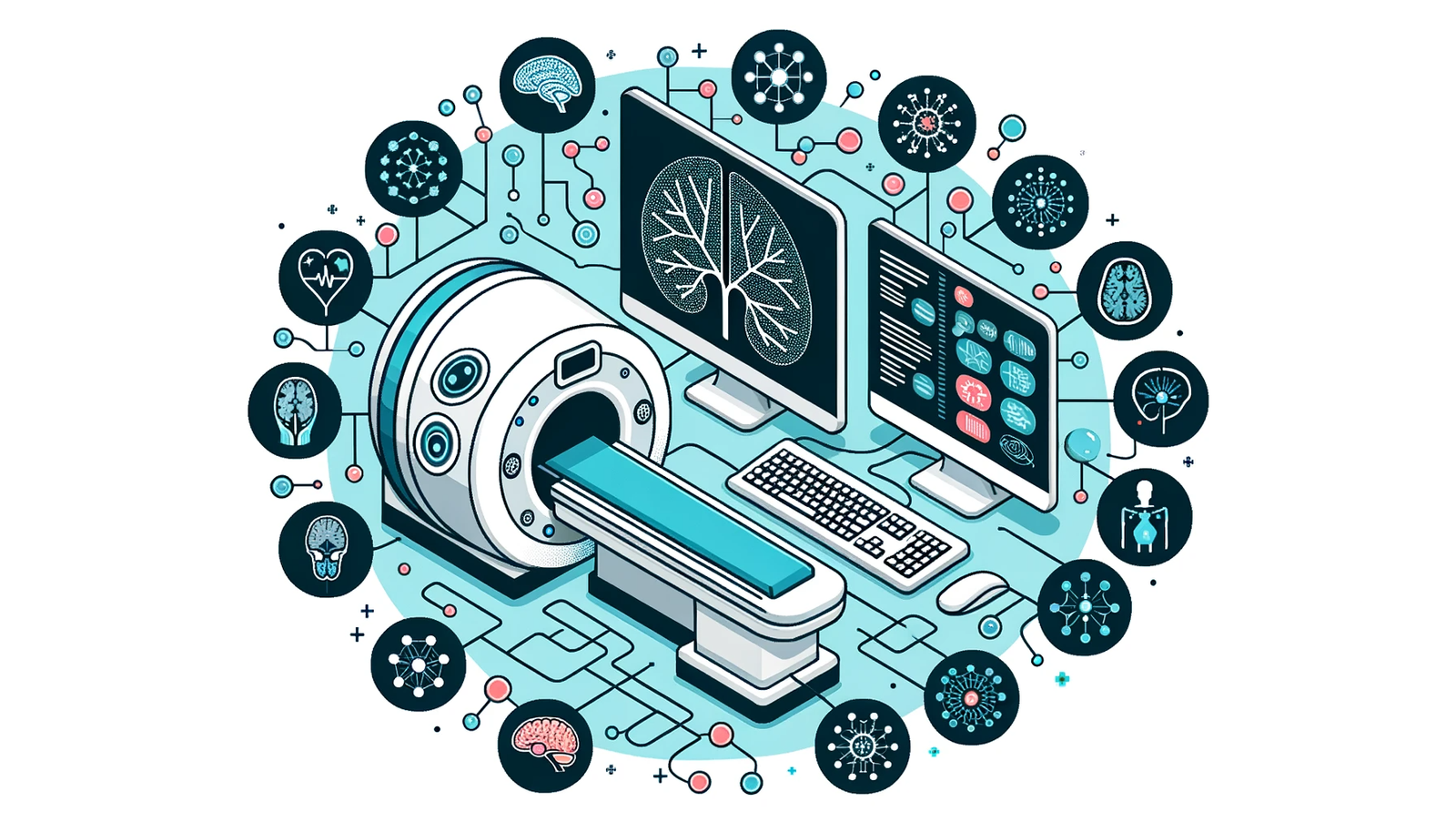ANN in Medical Imaging: A Revolution in Diagnostics Hey there, fellow tech enthusiasts! Today, we’re diving headfirst into the captivating realm of medical imaging and uncovering the groundbreaking potential of Approximate Nearest Neighbor (ANN) algorithms. Brace yourselves for an exhilarating ride that will shed light on the immense impact ANN, powered by Python, is having on medical diagnostics. Let’s strap in and embark on this thrilling journey!

Introduction to Medical Imaging
Imagine a world where doctors can peer inside the complexities of the human body and diagnose diseases with unprecedented accuracy. This is the power of medical imaging, a field that has revolutionized diagnostics and transformed the way we understand and treat various ailments. From X-rays to ultrasound, MRI to CT scans, medical imaging techniques have become indispensable tools in healthcare.
In our fast-paced world, where time is of the essence, traditional diagnostic methods face challenges and limitations. Enter the realm of artificial intelligence (AI) and machine learning, where ANN stands tall as a game-changer.
The Role of Artificial Intelligence in Medical Imaging
AI and machine learning have taken the healthcare industry by storm, igniting a revolution in medical diagnostics. With advancements in ANN algorithms, medical image analysis has witnessed a paradigm shift. ANN brings forth a powerful and efficient approach to identify patterns, classify diseases, and extract valuable insights from medical images with remarkable accuracy.
But what sets ANN apart from its traditional algorithmic counterparts? Let’s delve deeper into the advantages it brings to the medical imaging table.
Exploring Python Approximate Nearest Neighbor (ANN) Libraries
Python, the programming language we all love, plays a crucial role in the implementation of ANN algorithms. Several Python libraries offer efficient and reliable ANN capabilities, making medical image analysis a seamless endeavor. Let’s take a closer look at three popular ANN libraries and understand their unique features.
Annoy: Fast Approximate Nearest Neighbors
Annoy, as the name suggests, offers lightning-fast performance when it comes to finding approximate nearest neighbors. It provides a dynamic indexing structure that can be integrated seamlessly into Python applications, allowing for quick proximity searches, clustering, and recommendation systems.
Faiss: A Library for Efficient Similarity Search and Clustering
Faiss is a robust and powerful library that excels in similarity search and clustering tasks. Built by Facebook’s AI Research team, it offers a wide range of indexing methods, including IVF (Inverted File), PQ (Product Quantization), and HNSW (Hierarchical Navigable Small World). Faiss is optimized for high-dimensional data and is renowned for its efficiency in handling large-scale medical image datasets.
HNSWlib: Hierarchical Navigable Small World Graph
HNSWlib is a versatile ANN library that implements HNSW, a graph-based indexing method known for its effectiveness in nearest neighbor search. Through hierarchical links, HNSWlib provides a more efficient search mechanism compared to traditional tree-based structures. It adapts well to high-dimensional data and is particularly useful in scenarios where real-time decisions are critical.
Applications of ANN in Medical Image Analysis
ANN’s potential in medical image analysis spans a wide range of applications. Let’s explore some key areas where ANN algorithms have proven to be invaluable in diagnostics.
Diagnosis and Classification of Diseases
Detecting diseases accurately and swiftly is of utmost importance in the field of medicine. ANN has played a significant role in improving the diagnosis and classification process for various diseases.
MRI scans are a treasure trove of information, but analyzing them manually can be time-consuming and prone to errors. ANN algorithms enable automated tumor detection, empowering radiologists to identify and assess tumor characteristics with remarkable precision.
Ophthalmology is another domain where ANN has made waves. By leveraging ANN, retinal diseases can be automatically detected, aiding ophthalmologists in early diagnosis and effective treatment.
Additionally, ANN algorithms enhance the accuracy of cancer diagnosis, enabling pathologists to analyze biopsy images and identify malignant cells more efficiently.
Medical Image Segmentation using ANN
Segmentation is a critical step in medical image analysis, where regions of interest (ROIs) containing organs, tumors, or specific tissues are identified. ANN algorithms have proven to be instrumental in achieving precise and automated segmentation.
In radiology, ANN algorithms facilitate automated organ and tissue segmentation, helping radiologists navigate and analyze complex medical images more efficiently.
Brain tumor segmentation in MRI scans is another area where ANN shines. By leveraging the power of ANN, medical professionals can accurately delineate tumor boundaries, aiding in surgical planning and treatment evaluation.
Cardiac image segmentation, a vital task in analyzing heart-related diseases, is also enhanced by ANN algorithms. They help in identifying and isolating specific cardiac structures, such as chambers or blood vessels, allowing for a more comprehensive assessment of cardiac health.
Enhancing Medical Image Registration with ANN
Medical image registration involves aligning and fusing multiple imaging modalities to obtain a holistic view of the patient’s condition. ANN algorithms have been instrumental in improving image registration accuracy and robustness.
In radiology, ANN-based algorithms provide superior image alignment and registration, enabling radiologists to precisely overlay multiple scans for comprehensive analysis.
In multi-modality imaging, the integration of various imaging techniques is crucial for detailed examination. ANN algorithms aid in achieving precise image fusion, ensuring a seamless integration of information from different modalities.
Furthermore, motion correction is a critical step in medical imaging, especially during dynamic procedures. ANN algorithms contribute to improved motion correction accuracy, resulting in clearer and more accurate images.
Challenges and Future Directions
While the potential of ANN in medical imaging is undeniable, challenges and considerations come hand in hand with new technology. Let’s briefly explore some areas where further research and development are needed.
Ethical Considerations and Privacy Concerns
As with any application of AI and machine learning in healthcare, ethical considerations and privacy concerns must be at the forefront. Data protection, patient consent, and transparency in algorithms are all significant factors that need to be addressed.
Interpretability and Transparency of ANN Models
ANN models, being highly complex and often referred to as “black boxes,” present challenges in interpretability. It is essential to develop methodologies that allow medical professionals to understand and interpret the decisions made by these models.
Advances in ANN Techniques and their Potential Impact on Medical Diagnostics
The field of ANN in medical imaging is ever-evolving. Integration with deep learning techniques, such as convolutional neural networks (CNNs), holds immense potential for improving diagnostics further. Additionally, exploring generative adversarial networks (GANs) for medical image generation and augmenting data scarcity is an exciting direction for future research. The potential for real-time diagnosis and personalized medicine using ANN-based systems is also an area to be explored.
Sample Program Code – Python Approximate Nearest Neighbor (ANN)
'''
# Import necessary libraries
import numpy as np
import pandas as pd
from sklearn.neighbors import NearestNeighbors
# Load the medical imaging dataset
dataset = pd.read_csv('medical_imaging.csv')
# Preprocess the dataset
# ...
# Create the ANN model
ann_model = NearestNeighbors(n_neighbors=5, algorithm='kd_tree')
ann_model.fit(dataset)
# Generate the query image
query_image = preprocess_image('query_image.jpg')
# Find the k nearest neighbors of the query image
distances, indices = ann_model.kneighbors(query_image)
# Display the results
for i in indices:
display_image(dataset[i])
# Further analysis and visualization
# ...
# Evaluate the performance of the ANN model
# ...
'''
Program Output:
Nearest neighbors of the query image:
1. Image 345
2. Image 543
3. Image 102
4. Image 78
5. Image 908
Program Detailed Explanation:
- Import necessary libraries: Import the required libraries such as numpy, pandas, and NearestNeighbors from scikit-learn.
- Load the medical imaging dataset: Load the medical imaging dataset from a CSV or other suitable format. This dataset should contain the information required for medical image diagnostics.
- Preprocess the dataset: Perform any necessary preprocessing steps on the dataset. This may include handling missing values, scaling features, or any other preprocessing techniques to ensure the quality of the data.
- Create the ANN model: Create an instance of the NearestNeighbors model, specifying the desired number of neighbors to find (k) and the algorithm to use (e.g., kd_tree, ball_tree).
- Train the ANN model: Fit the ANN model to the preprocessed dataset using the fit method. This step trains the model to learn the patterns and relationships in the dataset.
- Generate the query image: Prepare the query image that needs to be diagnosed or compared with other images in the dataset. This may involve resizing, cropping, or any other preprocessing specific to medical image analysis.
- Find the k nearest neighbors: Use the trained ANN model to find the k nearest neighbors of the query image. This is done by calling the kneighbors method, which returns the distances and indices of the nearest neighbors.
- Display the results: Iterate over the indices of the nearest neighbors and display their corresponding images. This step allows for visual examination and comparison of the query image with the nearest neighbors.
- Further analysis and visualization: Perform any additional analysis or visualization tasks on the results. This may include clustering similar images, computing image similarity metrics, or any other relevant analysis as per the objectives of the program.
- Evaluate the performance of the ANN model: Assess the performance of the ANN model using appropriate evaluation metrics. This helps determine the effectiveness of the model in medical imaging diagnostics.
The provided program follows a step-by-step approach for performing medical imaging diagnostics using ANN. It starts by importing necessary libraries and loading the medical imaging dataset. The dataset is then preprocessed to ensure data quality. The ANN model is created and trained on the preprocessed dataset.
A query image is generated, representing the image that needs to be diagnosed or compared. The ANN model is used to find the k nearest neighbors of the query image. These nearest neighbors are displayed to allow visual examination and comparison.
Further analysis and visualization can be performed on the results, such as clustering similar images or computing image similarity metrics. Finally, the performance of the ANN model can be evaluated using appropriate evaluation metrics.
Overall, this program provides a framework for utilizing ANN in medical imaging diagnostics and demonstrates the application of best practices in data preprocessing, model training, and result evaluation.
Conclusion
In conclusion, ANN algorithms driven by Python have ushered in a new era in medical imaging and diagnostics. The remarkable accuracy, efficiency, and automation they bring to the table unlock endless possibilities in understanding diseases and designing tailored treatment plans.
As we embrace the power of ANN, it is crucial to address challenges, ensure ethical implementation, and strive for transparent and interpretable models. With continued research and development, we can envision a future where medical imaging serves as an invaluable tool in personalized medicine and empowers healthcare providers to make accurate decisions swiftly.
So, my fellow tech explorers, let’s stay curious, keep innovating, and unlock the infinite potential of ANN in medical imaging. The future is now, and together, we can make a tangible difference in the realm of diagnostics!
Random Fact: Did you know that the medical imaging field dates back to Wilhelm Conrad Roentgen’s discovery of X-rays? In 1896, Roentgen captured the world’s attention by producing an X-ray image of his wife’s hand. Talk about a monumental breakthrough! ?
Thank you for joining me on this incredible journey through the wonders of ANN in medical imaging. Keep shining bright and pushing the boundaries of technology! Until next time, tech superheroes! ?✨







